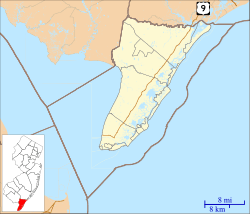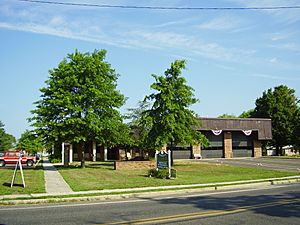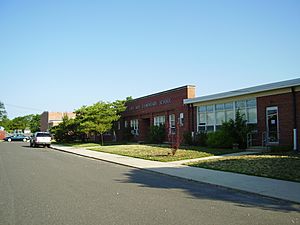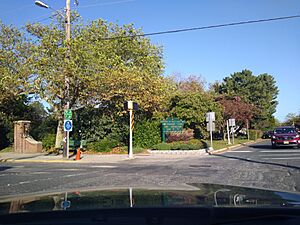West Cape May, New Jersey facts for kids
Quick facts for kids
West Cape May, New Jersey
|
||
|---|---|---|
|
Borough
|
||

Whilldin-Miller House
|
||
|
||

Location of West Cape May in Cape May County highlighted in red (left). Inset map: Location of Cape May County in New Jersey highlighted in orange (right).
|
||

Census Bureau map of West Cape May, New Jersey
|
||
| Country | ||
| State | ||
| County | ||
| Incorporated | April 17, 1884 | |
| Named for | Cape May / Cornelius Jacobsen May | |
| Government | ||
| • Type | Walsh Act | |
| • Body | Board of Commissioners | |
| Area | ||
| • Total | 1.19 sq mi (3.07 km2) | |
| • Land | 1.17 sq mi (3.04 km2) | |
| • Water | 0.01 sq mi (0.03 km2) 1.09% | |
| Area rank | 489th of 565 in state 14th of 16 in county |
|
| Elevation | 10 ft (3 m) | |
| Population
(2020)
|
||
| • Total | 1,010 | |
| • Estimate
(2023)
|
1,003 | |
| • Rank | 530th of 565 in state 13th of 16 in county |
|
| • Density | 860.8/sq mi (332.4/km2) | |
| • Density rank | 400th of 565 in state 9th of 16 in county |
|
| Time zone | UTC−05:00 (Eastern (EST)) | |
| • Summer (DST) | UTC−04:00 (Eastern (EDT)) | |
| ZIP Code |
08204
|
|
| Area code(s) | 609 | |
| FIPS code | 3400978530 | |
| GNIS feature ID | 0885435 | |
West Cape May is a Walsh Act borough in Cape May County, in the U.S. state of New Jersey. The borough, and all of Cape May County, is part of the South Jersey region of the state and of the Ocean City metropolitan statistical area, which is part of the Philadelphia-Wilmington-Camden, PA-NJ-DE-MD combined statistical area, also known as the Delaware Valley or Philadelphia metropolitan area. As of the 2020 United States census, the borough's population was 1,010, a decrease of 14 (−1.4%) from the 2010 census count of 1,024, which in turn reflected a decline of 71 (−6.5%) from the 1,095 counted in the 2000 census.
West Cape May was incorporated as a borough by an act of the New Jersey Legislature on April 17, 1884, from portions of Lower Township, based on the results of a referendum held two days earlier. The borough was reincorporated on April 11, 1890, and again on May 4, 1897. The borough's name derives from Cape May, which was named for 1620 Dutch captain named Cornelius Jacobsen May who explored and charted the area between 1611 and 1614, and established a claim for the province of New Netherland.
During Hurricane Sandy in October 2012, West Cape May was hit by 9.53 inches (242 mm) of rain, the most of any place in the state.
West Cape May had been a dry town until May 2012, when a new store opened after the Board of Commissioners approved the sale of a liquor license for more than $600,000. In 2008, voters approved a referendum that allowed the issuance of a single license for retail liquor sales and another for sale of alcoholic beverages at a restaurant. The borough had been dry for 128 years, where alcohol cannot be sold, affirmed by the results of a referendum held in 1940, joining Cape May Point, Ocean City and Wildwood Crest among municipalities in Cape May restricting the sale of alcohol.
Contents
History
The borough's history goes back to the time of the Lenape Native Americans. Several buildings in the borough date to the Colonial period. The area has a rich agricultural history which continues to be celebrated each year with a summer farmers' market, and strawberry, tomato and lima bean festivals. It has been known as the "Lima Bean Capital of the World." The Lima Bean Festival is an annual event held in West Cape May, New Jersey, the "Lima Bean Capital of the World", and is the world's only such celebration. It is held annually on the Saturday of Columbus Day weekend in Wilbraham Park.
West Cape May, once known as Eldredge, is one of the four jurisdictions that comprise Cape Island in Cape May County. West Cape May was incorporated as a borough by an act of the New Jersey Legislature on April 17, 1884, from portions of Lower Township, based on the results of a referendum held two days earlier. The borough was reincorporated on April 11, 1890, and again on May 4, 1897.
The Borough has reported ties to the Underground Railroad.
From 1881 to 1931, the Hastings Goldbeating Company was located in the Borough employing women to pound one-inch strips of gold into gossamer-thin sheets used for decorative arts. Women continued to do the "booking" of gold leaf sheets until 1961. A plaque indicating the location of the factory can be found on Goldbeaten Alley. It was this business, along with real estate speculation and subdivision of the land, that led to the Borough's incorporation in 1884.
Historic sites
The historic core of the Borough was placed on the National Register of Historic Places along with sections of the City of Cape May in 1976.
Whilldin-Miller House was added to the National Register of Historic Places on February 12, 2003. The original timber frame two-story house remaining in the rear was built by Joseph Whilldin about 1715, while the front portion of the house was built in 1860, making it one of the oldest remaining houses on Cape Island.
Geography
According to the United States Census Bureau, the borough had a total area of 1.19 square miles (3.07 km2), including 1.17 square miles (3.04 km2) of land and 0.01 square miles (0.03 km2) of water (1.09%).
The borough borders the Cape May County municipalities of Cape May City and Lower Township.
Demographics
| Historical population | |||
|---|---|---|---|
| Census | Pop. | %± | |
| 1890 | 757 | — | |
| 1900 | 696 | −8.1% | |
| 1910 | 844 | 21.3% | |
| 1920 | 967 | 14.6% | |
| 1930 | 1,048 | 8.4% | |
| 1940 | 934 | −10.9% | |
| 1950 | 897 | −4.0% | |
| 1960 | 1,030 | 14.8% | |
| 1970 | 1,005 | −2.4% | |
| 1980 | 1,091 | 8.6% | |
| 1990 | 1,026 | −6.0% | |
| 2000 | 1,095 | 6.7% | |
| 2010 | 1,024 | −6.5% | |
| 2020 | 1,010 | −1.4% | |
| 2023 (est.) | 1,003 | −2.1% | |
| Population sources: 1890–2000 1890–1920 1890 1890–1910 1910–1930 1940–2000 2000 2010 2020 |
|||
2010 census
The 2010 United States census counted 1,024 people, 493 households, and 294 families in the borough. The population density was 878.8 per square mile (339.3/km2). There were 1,043 housing units at an average density of 895.1 per square mile (345.6/km2). The racial makeup was 85.84% (879) White, 8.69% (89) Black or African American, 0.78% (8) Native American, 0.20% (2) Asian, 0.00% (0) Pacific Islander, 3.13% (32) from other races, and 1.37% (14) from two or more races. Hispanic or Latino of any race were 4.98% (51) of the population.
Of the 493 households, 14.0% had children under the age of 18; 46.0% were married couples living together; 10.3% had a female householder with no husband present and 40.4% were non-families. Of all households, 36.3% were made up of individuals and 17.2% had someone living alone who was 65 years of age or older. The average household size was 2.08 and the average family size was 2.66.
12.8% of the population were under the age of 18, 6.1% from 18 to 24, 13.5% from 25 to 44, 39.2% from 45 to 64, and 28.5% who were 65 years of age or older. The median age was 55.0 years. For every 100 females, the population had 93.2 males. For every 100 females ages 18 and older there were 88.0 males.
The Census Bureau's 2006–2010 American Community Survey showed that (in 2010 inflation-adjusted dollars) median household income was $48,281 (with a margin of error of +/− $6,924) and the median family income was $51,394 (+/− $3,176). Males had a median income of $42,361 (+/− $10,529) versus $43,860 (+/− $3,583) for females. The per capita income for the borough was $34,328 (+/− $4,010). About 8.4% of families and 6.7% of the population were below the poverty line, including 8.0% of those under age 18 and 4.8% of those age 65 or over.
African-Americans
African-Americans have been in West Cape May since the early 1800s. There is a West Cape May African-American Historical Society. Julie Lasky of The New York Times wrote that "until recently" the African-American community was "vibrant" but that by 2020 the percentage declined to 5%.
Education
The West Cape May School District serves students in pre-kindergarten through sixth grade at West Cape May Elementary School. As of the 2021–22 school year, the district, comprised of one school, had an enrollment of 88 students and 10.3 classroom teachers (on an FTE basis), for a student–teacher ratio of 8.6:1. In the 2016–17 school year, the district had 98 students, making it the eighth-smallest district in the state.
For seventh through twelfth grades, public school students attend the schools of the Lower Cape May Regional School District, which serves students from Cape May, Lower Township and West Cape May, along with students from Cape May Point who attend as part of a sending/receiving relationship. Schools in the district (with 2022–23 enrollment data from the National Center for Education Statistics) are Richard M. Teitelman Middle School with 433 students in grades 7-8 and Lower Cape May Regional High School (LCMRHS) with 757 students in grades 9-12. The high school district's board of education is comprised of nine members, who are elected directly by voters to serve three-year terms of office on a staggered basis, with three seats up for election each year. Seats on the board are allocated based on population, with West Cape May assigned one seat.
In 2013, the Lower Cape May Regional School District received a feasibility study that looked at alternatives to reconfigure the district, which had been established in 1956. The study considered Cape May City withdrawing from the regional district or the dissolution of the district, converting Lower Township's existing Pre-K–6 district to serve Pre-K–12, as the regional district's school facilities are located in the township. Cape May City and West Cape May could see annual savings approaching a combined $6 million from the dissolution.
Students are also eligible to attend Cape May County Technical High School in Cape May Court House, which serves students from the entire county in its comprehensive and vocational programs, which are offered without charge to students who are county residents. Special needs students may be referred to Cape May County Special Services School District in the Cape May Court House area.
History
Previously a West Cape May High School existed. In an era of de jure educational segregation in the United States normally only white students were permitted to attend though the state made exceptions. Ordinarily black students attended a different industrial high school. The district maintained separate white and black elementary schools.
Transportation
Roads and highways
As of May 2010[update], the borough had a total of 11.87 miles (19.10 km) of roadways, of which 8.82 miles (14.19 km) were maintained by the municipality and 3.05 miles (4.91 km) by Cape May County.
No Interstate, U.S., state or major county highways serve West Cape May. The most significant roads in the borough are minor county routes, such as County Route 607.
Public transportation
NJ Transit offers bus service between Cape May and Atlantic City on the 552 route.
Parks and recreation
Wilbraham Park is in West Cape May. Every October the lima bean festival is held in that park. There is also a strawberry festival in West Cape May, sponsored by the West Cape May Business Association.
Wineries
See also
 In Spanish: West Cape May para niños
In Spanish: West Cape May para niños








